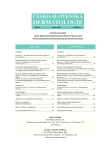Current Developments and New Treatment Options in the Therapy of Melanoma
Authors:
I. Krajsová
Authors‘ workplace:
Dermatovenerologická klinika 1. LF UK a VFN, Praha, přednosta prof. MUDr. J. Štork, CSc
Published in:
Čes-slov Derm, 85, 2010, No. 4, p. 189-195
Category:
Reviews (Continuing Medical Education)
Overview
Melanoma incidence is consistently rising as well as the detection of early prognostically favourable tumours. However, the number of advanced tumours with high risk of further progression is not decreasing. Adjuvant therapy with IFN α prolongs disease free survival in some patients but has only limited effect on prolongation of the overall survival. Chemotherapy and chemo-immunotherapy is only partially effective and they usually give only short-term response rates. Research of new treatment options is oriented, among others, also on immunomodulatory therapy that could break the immune tolerance of cancer cells. Blocking of the CTLA-4 (Cytotoxic T-Lymphocyte Antigen 4) seems to be one of the promising approaches. As long as the results of ongoing clinical trials are not confirmed, the most effective treatment remains an early surgical removal of the tumour.
Key words:
primary melanoma – adjuvant therapy – metastatic melanoma – immunomodulation – anti CTLA 4 – autoimmunity
Sources
1. Bouwhuis, M., Suciu, S., Testori, A., et al.: Phase III trial comparing adjuvant treatment with pegylated interferon alfa 2b versus observation: prognostic significance of autoantibodies – EORTC 18991. J Clin Oncol, published ahead of print, April 12, 2010.
2. Garbe, C, Peris, K., Hauschild, A., Saiag, P., et al.: Diagnosis and treatment of melanoma: European consensus-based interdisciplinary guideline. Eu J Cancer, 2010, 46, 270-283.
3. Gogas,H., Eggermont,A.M., Hauschild,A., et al.: Biomarkers in melanoma. Annals of Oncol, 2009, 20(6), vi8-vi13
4. Gogas, H., Ioannovich, J., Kirkwood, JM., et al.: Prognostic significance of autoimmunity during treatment of melanoma with interferon. N Engl J Med, 2006,354(7),709-718-
5. Kirkwood, JM., Tarhini, AA., Panelli, CM., Moschos, JS., Gogas, JH.: Next generation of immunotherapy for melanoma. J Clin Oncol, 2008,26, 3445-3455.
6. Mocellin, P., Pasquali, S., Rossi, CR., Nitti, D.: Interferon alfa adjuvant therapy in patients with high risk melanoma: a systematic review and meta-analysis. J Natl Cancer Inst, 2010, 102(7), 493-501.
7. Mouawad, R., Sebert, M., Michels, J., Bloch, J., Spamo, JP., Khayat, D.: Treatment for metastatic melanoma: old drugs and new strategies. Crit Rev Oncol/Hematol, 2009,doi: 10.1016.
8. O’DAY, SJ., HAMID, O.,et al.: Targeting cytotoxic T-lymphocyte antigen-4 ( CTLA-4): a novel strategy for the treatment of melanoma and other malignancies. Cancer, 2007, 110(12), 2614-2627.
9. Ridolfi, L., Ridolfi, R.: Anti-CTLA-4 therapy in melanoma: role of ipilimumab. Expert Rev. Dermatol., 2009, 4(3), 199-210.
10. Sanki, A., Kam, CAP., Thompson, JF.: Long-term results of hyperthermic, isolated limb perfusion for melanoma. Ann Surg, 2007, 245(4), 591-596.
11. Tawbi, H., Nimmagalda, N.: Targeted therapy in melanoma. Biologics: Targets&Therapy, 2009,3, 475-484.
12. VErma, S., Quirt, I., McCready, D., et al.: Systematic review of systematic adjuvant therapy for patients at high risk for reccurent melanoma. Cancer, 2006, 106,1431-1442.
13. Wolchok, JD., Hoos, A., O’Day, S., Weber, JS., et al.: Guidelines for the evaluation of immune therapy activity in solid tumors: immune-related responce criteria. Clin Cancer Res, 2009, 15(23), 7412-7420.
14. Wolchok, JD., Linette, G., Negrier, S., Thomas, L., et al.: Ipilimumab monotherapy in patients with pretreated advanced melanoma: a randomised, doubleblind, multicentre, phase 2, dose-ranging study. 2009, doi: 10,1016/S1470-2045.
15. Česká onkologická společnost ČLS JEP. Kap.15, Zhoubný melanom kůže. In: Zásady cytostatické léčby maligních onkologických onemocnění. 10.aktualizované a doplněné vydání, ČOS ČLS JEP, ISBN 978-80-254-4859-5, 2010, 65-67.
Labels
Dermatology & STDs Paediatric dermatology & STDsArticle was published in
Czech-Slovak Dermatology

2010 Issue 4
Most read in this issue
- Nystatin – Newly Available Drug for Extemporaneous Preparation
- The Follow-up of Patients with Severe Acne Vulgaris Treated with Systemic Isotretinoin
- Current Developments and New Treatment Options in the Therapy of Melanoma
- Pseudoxanthoma elasticum
